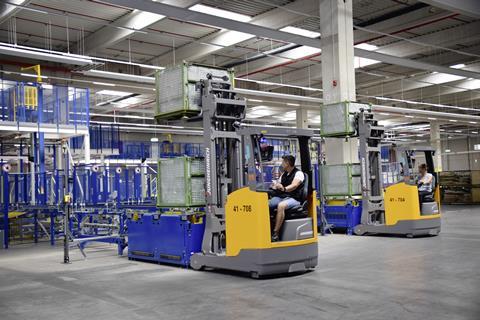Mercedes-Benz has added a state-of-the-art service parts warehouse to its global spare parts logistics centre in Germersheim, Germany. Klaus Ziemsky, director of global parts operations and site manager at the centre, tells Marcus Williams about the latest automation technology being used there
Mercedes-Benz is using new ergonomic working principles and the latest digital technology to automate processes at its global parts logistics centre in Germersheim in Germany. Machine learning and cloud computing are also being used to help with demand planning for the high volume of parts the facility receives and distributes daily. The carmaker has invested €100m ($115m) in a new warehousing complex that was completed in July and officially opened at the beginning of August, exactly 30 years after the original site opened.

Overall, Germersheim’s central warehouse holds around 500,000 different passenger car and commercial vehicle parts as well as Mercedes-Benz accessories across an area of more than 1.4m sq.m. The centre handles service parts for Mercedes-Benz, smart and Fuso vehicles.
According to Klaus Ziemsky, director of global parts operations and site manager at Global Logistics Center Germersheim, the expansion was deemed necessary to keep up with a growing premium car market and the significant growth in parts volumes.
“We guarantee the supply of spare parts for many years after the end of production of each model,” he says. “Additionally, we believe that the premium car market keeps growing and our expectation includes a significant increase in part numbers and volume. Consequently, we are and will be structuring our parts logistics even more efficiently, so that we can continue to provide the best possible service for our customers around the world.”
The new facility consolidates “highly dynamic material” from other logistics facilities at Global Logistics Center Germersheim, creating space to distribute high- and slow-moving items more efficiently, according to Ziemsky.
Automated delivery
The new 80,000 sq.m high-bay warehouse features a number of high-tech storage and retrieval devices, including an integrated conveyor that uses a combination of chain, hydraulic and electric pallet conveyors to directly send parts picked in a central part picking location to the high-bay storage areas. The warehouse also operates on a ‘goods-to-person’ ergonomic principle, in which parts are delivered to employees by automated delivery systems.

Ziemsky explains that work on the new facility began with an internal planning phase in September 2016. Exactly one year later the company broke ground on the site and by the end of 2019 the technical building equipment was installed and the testing phase of the storage technology and IT systems started. Mercedes-Benz was able to continue operations at the Germersheim site throughout all phases of the construction, instalment of equipment and testing of the technology.
“Since the global logistics centre started operations, the site has been expanded several times,” explains Ziemsky. “Therefore, we have many years of experience in building and connecting new facilities to the existing warehouse while in full operation. A testing phase ensured that daily operations could continue without disruption.”
Full commissioning took place after an intensive test phase in July 2020. That phase was interrupted by the impact of the coronavirus pandemic and Mercedes-Benz took the decision not to hold an official inauguration celebration in July given the priority for the health and safety of its employees (see below).
Goods-to-person concept
Parts are delivered by truck from Mercedes’ global supply base (and from its own production plants) and moved to the central pick zone at the warehouse. The in-floor electric conveyor system now in operation moves medium and bulky spare parts from there to the high-bay storage areas.
“It is equipped with 110 individual carriers working in three loops with intelligent pallet conveyor technology that is used for a flexible and decoupled material flow in the new warehouse,” says Ziemsky.

That high degree of automation equates to higher throughput rates and the new order picking concept for medium sized parts contributes to that efficiency and better ergonomics. The picking container arrives on its own at the workstation, is tilted towards the employee. The employee stands on a height-adjustable platform and is able to adjust the working height individually.
“The improvement and further development of the workstations for our employees was very important for us,” says Ziemsky. “We want to create the best possible working environment for our staff. A new concept for picking medium parts – the ‘goods-to-person’ principle – is an important contribution to ergonomics.”
Predicting the parts
The Germersheim logistics facility manages between 40,000 and 70,000 parts a day for distribution globally, depending on the purchasing orders received, and is focused on a continuous improvement programme to manage the volumes.
“We put our existing processes to the test every day in order to develop them even further,” says Ziemsky. “With the help of these continuous improvement processes, we strengthen the competitiveness of our plant and adapt our processes to changing circumstances. A great amount of effort, operational excellence and detail in the logistics processes are crucial for our daily procedures.”
Mercedes-Benz is also using the latest digital technology, including machine learning and cloud computing, to help with demand planning for those daily volumes.
“When it comes to improving the demand prediction for the parts market, we evaluate more and more data sources and use these results for our forecast,” he says. “Regularly we use point-of-sale data as basic input. With more sophisticated machine learning models, the used statistical forecast strategies can be enhanced for specific parts.”
As a crucial step towards even better prediction of future demands, the company is using cloud computing for more complex forecasting to maintain efficiency and flexibility.
Coping with the coronavirus
When the coronavirus hit at the beginning of the year, Mercedes-Benz responded quickly to protect the health and safety of its employees.
“At the beginning of the year, hardly anybody would have believed how quickly and seriously, we would all be affected by the spread of Covid-19 pandemic,” Ziemsky reflects. “For us, the health and safety of our employees has always the highest priority.”
According to Ziemsky Mercedes took early action and defined an extensive package to protect against infection. The measures taken are continuously checked and adapted requirements.
“The employees of our worldwide logistics centres kept working under strict hygiene and occupational health measures in order to ensure the supply of spare parts globally,” he says.
During the height of the pandemic in Germany, Germersheim focused on urgent orders safeguarding the mobility of service vehicles for the police, fire services, technical support, rescue services and emergency medical personnel around the world. It also prioritised the maintenance of important logistics services for such things as the supply of food, medicine and fuel.
“Despite these developments and all of the associated challenges, one thing has become clear since the beginning of the Covid-19 pandemic: we stick together and keep our customers mobile!” says Ziemsky.

On an operational level, global spare parts inventories have been steered from Germersheim, with employees successfully managing the priorities and quickly adapting systems and processes to changing requirements. Ziemsky says the inbound delivery of parts by Mercedes-Benz’s suppliers varied from market to market depending on the recommendations and orders of the national authorities, but outbound aftersales parts were moved according the priority for emergency services mobility.
“Due to the huge amount of stocked parts and in close cooperation with our suppliers and our worldwide logistics centres – our central warehouse in Alabama, US and the 40 affiliated wholesale locations located on six continents – we were able to safeguard emergency orders also during the shutdowns,” explains Ziemsky.
International logistics network
More generally the materials handling technology and strategy being used at the new warehouse reflects the progress being made more widely across Mercedes-Benz’s aftersales network, and that of its parent company Daimler.
“We are expanding our international logistics network following the development of our customers and suppliers,” says Ziemsky. “An example for this is our new hub for the North American market. In connection with the expansion of our industrial engagement in Alabama, Mercedes-Benz also invested in a new After-Sales North America Central Warehouse hub in Bibb County, about five miles from the Tuscaloosa car plant.”
The company is also preparing its aftersales network for the growth in electric vehicles (EVs). Mercedes-Benz and smart have been making EVs for more than a decade and supplying the service parts to keep them running.
“With the full electric smart or Mercedes A-class, the first hybrid in the S-Class segment or the B-Class fuel cell – we had to consider the electrification for the aftersales supply chain at an early stage,” says Ziemsky.
Importantly, that included the storage and handling of high-voltage batteries, which were handled along the guideline and processes already established for the remanufacturing of EV-powertrain components. The process is ongoing but Ziemsky says Mercedes-Benz After-Sales is well prepared and that a total of five fully electric models and more than 20 model variants of plug-in hybrid models will be available by the end of 2020


























![Global[1]](https://d3n5uof8vony13.cloudfront.net/Pictures/web/a/d/s/global1_726550.svgz)













No comments yet